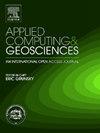GeoSim: An R-package for plurigaussian simulation and Co-simulation between categorical and continuous variables
Abstract
Plurigaussian simulation is widely used to model geological facies in geosciences and is predominantly applied in mineral deposits and petroleum reservoirs exploration. GeoSim package builds geostatistical models of categorical regionalized variables via conditional or unconditional Plurigaussian simulation and co-simulation. Co-simulation between Gaussian Random Fields representing the geological facies and other numerical variables accounting for auxiliary hydrological or geophysical quantities, is also available in this package with the definition of a linear coregionalization model. The algorithm is not restricted by the number of simulated facies and the number of truncated Gaussians, while parts of the code requiring heavy computations are compiled in C++ taking benefits of the integration between R and C++. In this work, we introduce the GeoSim package and demonstrate its capabilities. We present a 3D application focused on a lignite mine in Greece, where we investigate the Plurigaussian simulation and co-simulation of five geological facies (categorical variables) and the lower calorific value (continuous variable). The findings of our study highlight the significant benefits of Plurigaussian and co-simulation to capture the geological spatial heterogeneity.

 求助内容:
求助内容: 应助结果提醒方式:
应助结果提醒方式:


